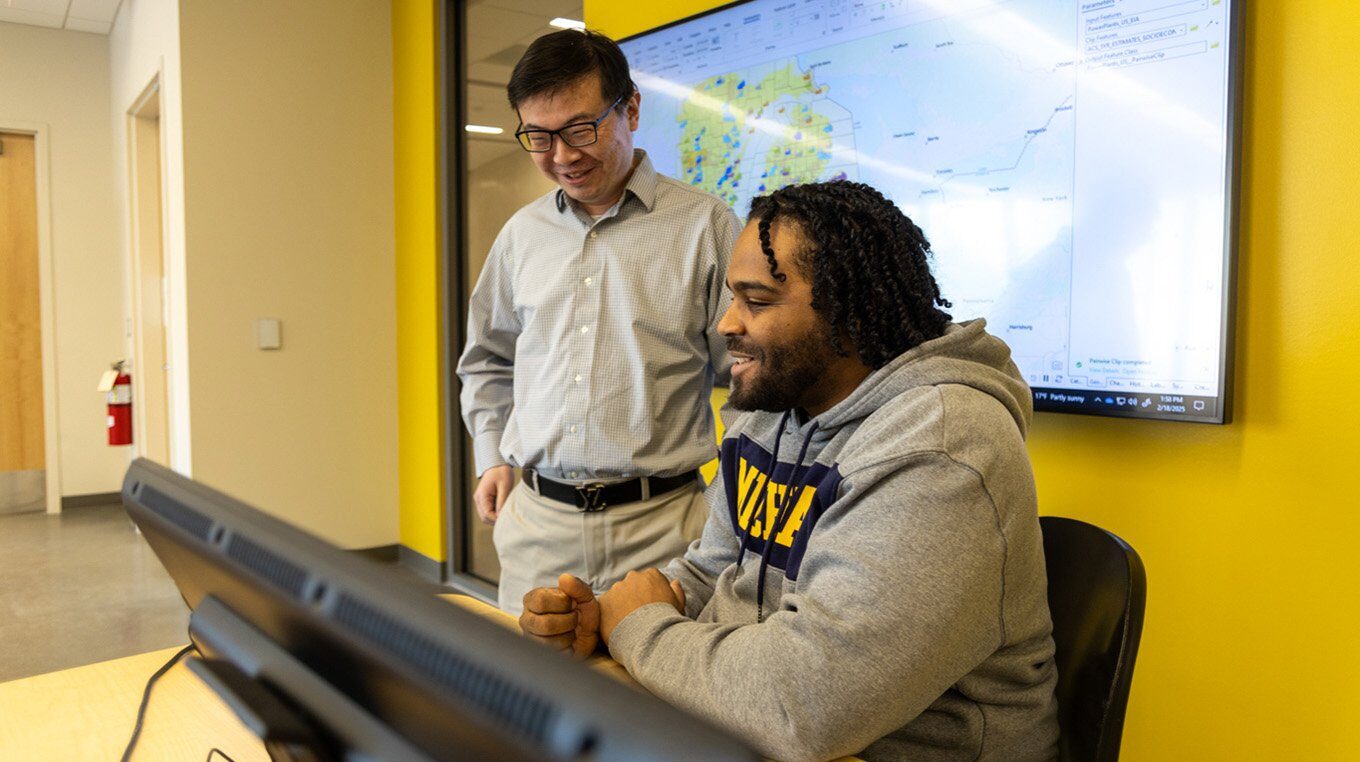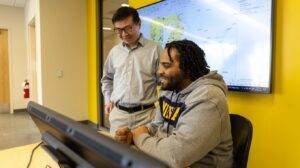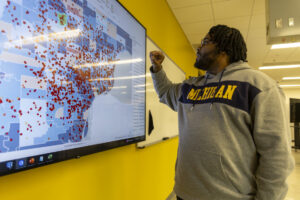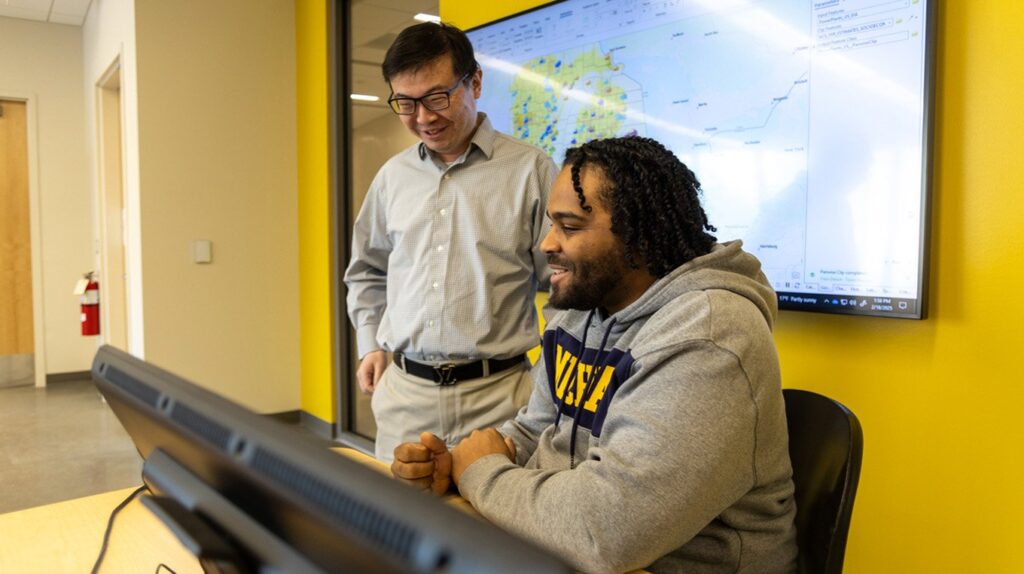Source: UM-Dearborn

Electrical and Computer Engineering Professor Wencong Su (left) and doctoral student LaRico Andres have teamed up on a number of research projects focusing on energy justice. Photo by Annie Barker

Electrical and Computer Engineering Professor Wencong Su (left) and doctoral student LaRico Andres have teamed up on a number of research projects focusing on energy justice. Photo by Annie Barker
In 2020, Electrical and Computer Engineering Professor Wencong Su was looking for an undergraduate student to assist with a project focused on adding innovative energy efficiency measures to the already LEED-certified Engineering Lab Building.
At the time, Su was teaching all graduate courses so he didn’t have many undergrads in his orbit. So Su asked for a little help from one of his graduate assistants, who emailed the job posting to the students in a 200-level lab.
LaRico Andres, a sophomore and recent transfer from Henry Ford College, thought it sounded interesting and reached out to Su with his resume. Su remembers Andres didn’t exactly fit the description of the type of student who usually applies for these kinds of opportunities. Andres was a few years older than Su, already had a full-time job working as an instrument tech at the Great Lakes Water Authority, and his GPA at the time wasn’t knocking anyone out. But after the two chatted for a little while, Su offered him the job. Andres was personable, seemed excited to learn, and though he was a research novice, it turned out his background in instrumentation was actually quite relevant to the types of things they would be investigating in the Engineering Lab Building.
Andres excelled on the project and it led to many more opportunities to work alongside Su. On one project supported by the National Science Foundation’s I-Corps — a program that helps researchers translate their laboratory work into marketable products — Andres traveled to conferences in Orlando, San Diego and Austin, completing a flurry of more than 100 interviews with industrial professionals in seven weeks about a product Su’s lab was developing. On another project, he and Su created an app that used the ELB’s building management software and the utility’s fuel profile to give users an idea of what being a building occupant added to their personal carbon footprint. As you’d expect, Andres picked up a lot of skills working with Su. But as often happens when two people spend a lot of time together, Andres and Su also started talking about things other than their work. Andres jokes that they initially bonded over the fact that they “both like to eat.” But the conversations gradually grew more personal. Both men had daughters, so they talked about their kids. Su shared some of the challenges he faced when he first came to the United States for college and he knew very little English. Andres reciprocated with stories about some challenges he faced growing up in Detroit, not always having enough money to pay all the bills at once, and some things that happened when he was younger that tripped up his plans to go to college earlier in his life.
Su says he enjoyed Andres’ perspective — in part, because Su is someone who’s interested in people, and the ups and downs of Andres’ life made for a compelling personal story. In addition, Su says he’s always been interested in Detroit, and through Andres, a lifelong Detroiter, he enjoyed learning about a side of the city that “you don’t hear about on the TV news.” Interestingly, at a certain point, both men noticed that many of their personal conversations weren’t actually that separate from their field of study: energy systems. For example, Andres shared stories about how, in his family, when the power would go out, that meant you didn’t open the fridge so his grandfather’s insulin wouldn’t spoil. Or how, if the power was out long enough, they’d start barbequing the meat they had in the freezer so it wouldn’t go to waste. Or how he and his relatives used to take turns refilling his grandmother’s boiler when she couldn’t afford to fix it right away. “The biggest burden a lot of my people have is energy, whether it’s fuel, gassing up your car going to work, or just trying to keep your house warm,” Andres says. “I know what it’s like to struggle to pay a utility bill and choose between paying that bill on time or buying food. I know people whose furnaces go out and can’t afford to get them fixed. That’s the impact energy has. Energy helps. But if you don’t have a lot of money, energy can be a burden.”

Andres shows off an interactive mapping tool he helped create that explores the connection between historical real estate redlining and disparities in energy access. Photo by Annie Barker
Andres’ testimony left an impression on Su, and eventually the two of them started kicking around ideas for projects focused on energy justice, an emerging field that focuses on equity, affordability, accessibility and participation in the energy system and the ongoing transition to new energy technologies. That lens became the cornerstone of their 2023 Summer Undergraduate Research Experience project, in which Andres helped create an interactive mapping tool that explores the connection between historical real estate redlining and disparities in energy access in metro Detroit. Using Andres’ dashboard, a user can quickly toggle through different layers and explore whether a neighborhood is formerly redlined, where current utility outages are and their causes, locations of renewable energy installations and EV charging stations, as well as census data that provides demographic information about the people currently living in the neighborhood. One of the big reveals from Andres’ work is that metro Detroit neighborhoods that were historically redlined tend to be lower-income, non-white, have power outages that tend to be longer, and have less access to renewable energy and EV charging infrastructure. Their work on the app led to an IEEE conference publication in 2023.


